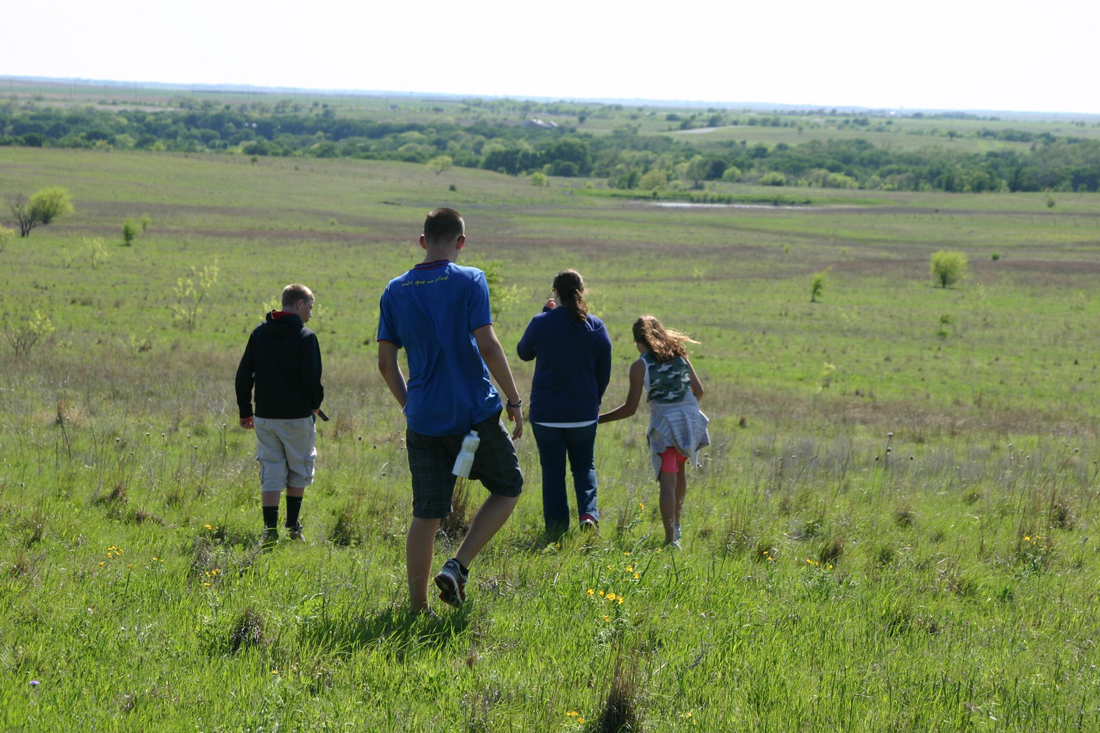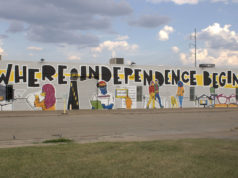Teenagers from a Fort Worth homeless shelter climbed out of a van and looked across what seemed a vast prairie to their urban eyes.
They were at the Fort Worth Prairie Park to get some fresh air and a change of scenery. Leading them on a three-mile hike was Jarid Manos, founder and CEO of the Great Plains Restoration Council, a nonprofit group devoted to protecting prairies and showing young people the interdependence of humans and nature.
“Few people alive have walked on this type of prairie –– it’s almost all gone,” he said.
One teen expressed doubts that she could walk three miles –– she might pass out, she said.
“We’ve been given first aid training; we know what to do,” shelter mentor Paul Fisher said.
Another teen worried about snakes.
“I’ve never seen a snake out here,” Manos said.
Other worries and excuses were aired and shot down. Finally, they all began walking, taking frequent stops to listen to Manos or volunteer JoAnn Collins talk about grasses, trees, and animals.
Manos has spent seven years trying to ensure that this 2,000 acres of prairie land known as Rock Creek Ranch will be preserved. It’s one of the largest and last remaining patches of prairies in the area, a window to the city’s past, before cattle, fencing, and urban development changed the landscape. The prairie sits near the path of the Chisholm Trail Parkway on Old Granbury Road near Benbrook Lake.
Few people thought Manos would ever save the prairie because his nonprofit group has little money, and the land is considered prime real estate. But things have been jelling recently.
“There is a renewed push for this,” Manos said. “There is much more public involvement.”
The restoration council created an offshoot group, the Friends of the Fort Worth Prairie Park, and recruited more volunteers. Grants are trickling in. And the group secured protected status for 235 crucial acres that includes Rock Creek, a tributary of the Trinity River’s Clear Fork.
The Texas General Land Office sold it to a private owner who agreed to preserve the property as prairie.
“The owner is a concerned citizen who supports the ecological integrity of the area and would like to see it be a park,” Manos said.
The environmentalists also convinced the North Texas Tollway Authority to lessen the tollway’s impact. The authority agreed to minimize lighting, to reseed rights-of-way with native vegetation, and to wash its brush-cutting equipment before mowing, to help keep invasive species off the land.
Land Office spokesman Jim Suydam said the property is a ranch, not a park, and he wondered why the tollway authority is appeasing Manos, who doesn’t even own the property.
Then Suydam answered his own question: “He’s very persuasive,” he said.
Protecting the remaining 1,800 acres won’t be easy. The Land Office bought the property in late 2005 when the economy was ginning along and planned to sell it to developers and turn a profit. The recession might have slowed that plan.
The Land Office buys and sells land on behalf of the state’s $25 billion Permanent School Fund. The agency bought the ranch because of its location near Fort Worth and the proposed toll road, now under construction, that runs along its property line. Suydam won’t reveal what the agency paid, but said it is looking to get $12,000 an acre –– or about $21 million –– for the property.
Some park enthusiasts suspect the Land Office bought the ranch near the top of the market and can’t sell it until the economy more fully recovers. In the meantime, the agency has been open to Manos’ pleas. The question is, what will happen when a developer dangles enough money in front of the Land Office?
State Rep. Lon Burnam of Fort Worth doesn’t think the Land Office should be in the business of real estate speculation. He doesn’t like the fact that the agency legally isn’t required to reveal how much taxpayer money it spent on the property.
“I believe in open government,” Burnam said. “One can question or challenge the appropriateness of the Land Office being involved in these kind of land investment strategies, but they did, and that is what puts us in a position to save this land.”
The Restoration Council’s chances of success would be slim if the land were in private hands. Commissioner Jerry Patterson has met with council members, listened to their visions of a prairie park, and told them the agency’s board would entertain any competitive offer.
“The General Land Office isn’t the parks department,” Suydam said. “Decisions here are driven by a return on investment. The financial interests of the schoolchildren of Texas come first.”
Manos is convinced his nonprofit will save the land. Right now, the land is available only for planned visits, many of them led by Manos and his volunteers. They are now trying to protect the rest of the property and establish a visitor center and ecological health institute there.
Collins began volunteering with the council after reading a Fort Worth Weekly profile of Manos years ago (“Great Pains for the Great Plains,” June 1, 2005). An Arlington teacher, she watched her two stepsons deal with drug and alcohol problems during their wild youths, and she wondered if more exposure to nature might have helped them.
“What drew me to Jarid is the work he does with youth,” she said. “I want kids to understand their history and what the land means to them and society before we ruin it. Once we cover it up, it’s hard to get back.”
Six years ago, Patterson wanted evidence that Manos had public support for his park idea. Manos made a pitch to city and county leaders. County officials pledged $1 million toward the purchase price. City officials responded favorably at first, but the Fort Worth City Council, led by then-Mayor Mike Moncrief, later backed away, fretting that the park might infringe upon the tollway.
Since Collins and Manos don’t have $21 million in their pockets, they’ve had to think creatively and apply pressure to the Land Office through letter-writing campaigns.
Fort Worth was Queen City of the Prairie back in the 1800s, a busy town built amid more than a million acres of grassland. Few of those acres remain as prairie today.
The shelter kids weren’t all appreciative. One young man wore headphones and listened to music throughout the hike. “I don’t even care about plants,” he grumbled.
But others had a blast, including one girl with little experience in the outdoors.
“It feels good out here,” she said, enjoying a breeze. “I’m not used to walking on grass. I’m used to straight-up concrete.”
Before the two-hour tour ended, she’d skipped rocks across a pond for the first time and seen her first rabbit in the wild. The girl said she hoped Manos could figure out a way to save the land for other kids to enjoy.
Seven years after he started work on it, Manos’ vision still seems far-fetched. But stranger things have happened.
“I love dreamers and people who think out of the box, and Jarid Manos is like a dog on a bone,” Burnam said. “If anybody can pull it off, he can.”













Joe Kuban would certainly enjoy this wonderful piece Jeff, good job.